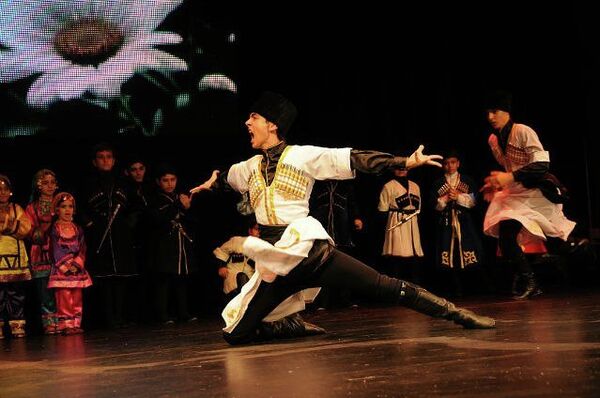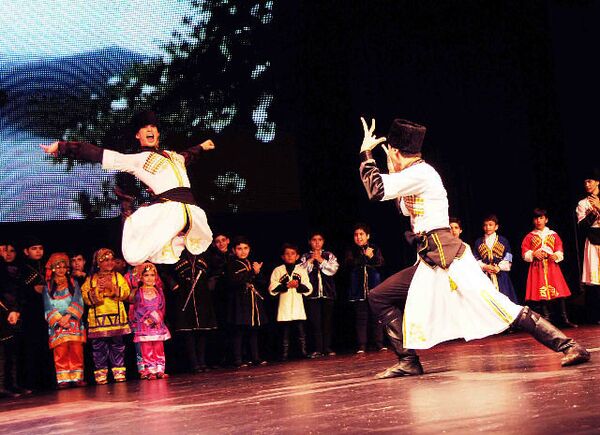BROOKLYN, New York, July 30 (By Maria Young for RIA Novosti) – In a roomful of pint-sized performers, swirling and stomping like they were born to dance in their forefathers’ footsteps, a tanned and muscular Anatoliy Vartanian is waving his arms like a madman, shouting frustration in a voice filled with disgust, his salt-and-pepper hair jutting out at crazy angles, outrage spewing from his soul.
“What are you thinking??! Tighter! You’re not trying!” he fumes in his native Russian tongue, inches away from the face of a wide-eyed eight-year-old boy who instantly manages to sharpen his moves, leaping higher, turning with a precision that wasn’t there a moment before.
That’s the kind of respect you command when you are one of the most famous lezginka dancers of Dagestan, where this fast-paced, frenzied dance, filled with jumping, twirling and high-pitched screams originated hundreds of years ago.
“I love each of them tremendously... but when I shout at them, when I tell them off, I have a result. If I were soft with them, they wouldn’t have danced like that,” said Vartanian through a translator in an interview with RIA Novosti.

It is late in his upper-floor studio on a non-descript street in Brooklyn, New York where dozens of kids with family ties to Dagestan, Azerbaijan and the Caucasus region of Russia have just finished their Friday night classes.
“There’s a fire inside of me; I’m giving them so much and I want them to give even a little bit back. But not all of them do, and that’s why I shout. I love every hair on their heads, but when they are lazy, when they’re fooling around, it drives me insane,” he added.
You can almost imagine some young American children in such a class dissolving in tears, their parents frantic about the effects of such treatment on fragile young self-esteems.
And yet, the kids in this Brooklyn studio clearly adore Vartanian. They idolize him. They practically worship the man, whispering his name in a tone of something close to reverence. Their parents watch the classes on a monitor from another room, laughing at some of the antics but clearly proud of their children carrying on a cultural tradition from the homeland.
Vartanian, who is 77 years old, is more than a teacher. He is the grand patriarch of this incredibly close-knit family of sorts of first-generation Americans who share a common heritage. They look to him as a cherished grandfather. And the more he yells, the more loved they feel.

“Anatoliy has his own way of teaching. When it’s during a class he can be loud… precisely because he likes everything to be perfect to the tee. But outside of class we all refer to him as our grandfather. He drives us home, he comes to our parties with us, we have our own little family gatherings,” said 14-year-old Alexandra Goldshmidt, who has been studying lezginka with Vartanian since she was eight.
“We wouldn’t say he’s nuts. It’s just, that’s the way he teaches, that’s the way he trains us, and the way he raises us,” she added.
Eighteen-year-old Adi Avishalom was an infant when he came to the United States with his family as refugees from Baku, Azerbaijan. There, lezginka is quite popular, he said.
Avishalom has been studying lezginka for as far back as he can remember, and describes the dance, with its sharp, angular movements, pounding drumbeat and fiery music, in almost poetic terms.
“You can get so much emotion out of it. It’s very aggressive, so you can get your anger out and at the same time, you can dance it very sharply, very accurately, but not forcefully. It can be gentle at the same time,” Avishalom said.
“Hip hop’s too common. It doesn’t touch my heart like lezginka does. When I dance this, I just get a joy that’s pretty extraordinary,” he added.
Avishalom’s extended family of several hundred people in the New York area, along with neighbors and friends who migrated to the United States, are thrilled to find their native dance alive and kicking through the next generation.
“Even though it’s not very popular among New Yorkers or even Americans, it’s very popular among our culture. So whenever we get together for a wedding we would dance this and everyone would be shocked. They’d be like, ‘Wow, where’d you learn this?’” he said.
But it almost didn’t happen.
Vartanian was a leading dancer with the Lezginka Ensemble in Dagestan for years, performing for crowds packed with admiring fans and heads of state across Europe, and was named an Honored Artist of Dagestan. His was a classic “rags-to-riches” tale that began in an orphanage in Dagestan and led him to the top of his field.
By the time he reached a level of fame, Vartanian said, he was “living grandly” and “could get a studio for free. They just wanted me to be there. “
When he moved to the United States in the mid-1990s after the collapse of the Soviet Union, he was in his late 50s and found no such fame or fortune. People in America didn’t recognize his face and they had never heard of lezginka. He struggled to find a job that was suitable, working first in a kebab house, then as a chef, and later in a bakery.
“I changed lots of jobs, and there was a moment when I wanted to leave. I went to Kennedy Airport three times,” planning to go back home, but turned around each time, he remembered. “There wasn't much for me here.”
He missed his homeland, and he missed lezginka, which he called “the dance of the mountains,” and “a temperamental dance that could even make the dead want to come back to life.”
That bleak existence began to change through a stroke of fate, a chance meeting in 1999 with some friends from Makhachkala, the capital of Dagestan, and their sons. Young Zoriy would become his first student in the United States.

“I started practicing with him, then at a certain point I showed his skills, and people started calling me, 'Can you teach my daughter? Can you teach my son? Can you stage a wedding dance?’”
Working with overjoyed parents and the local community, he found studios for the kids to dance in, and gradually the number of students grew to more than 60.
“In the beginning the kids were looking at the clock to see when the session would end, and now I can’t make them leave the studio,” he said.
Today, Vartanian is the director and choreographer of the LezginkaNYC dance ensemble, which has performed in Manhattan and Washington, as well as scores of private parties and celebrations. At nearly 78, he has found a new home and a family at last.
“I’m feeling amazing thanks to these kids,” he said, adding with a smile, “Those are the people for whom I live. I love them very much because they are like my children.”

